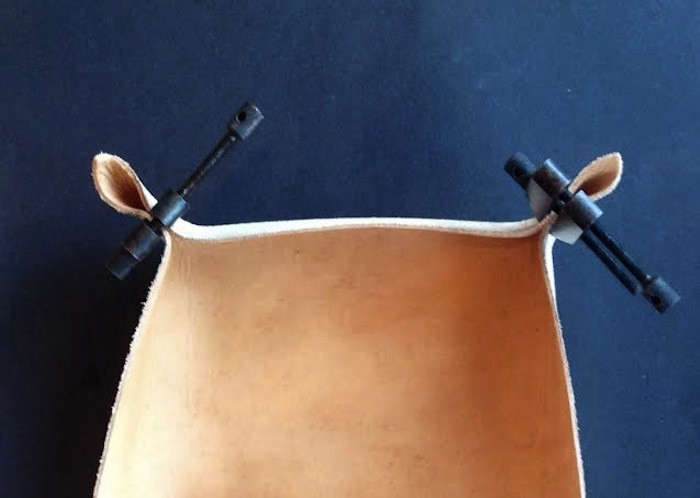First there were leather baskets (see our recent post: Woven Leather Storage Baskets), then I spotted the custom bedside trays at various Ace Hotels and decided that the junk removed from the average pocket (keys, lint, and change) looks much better when enveloped in a nest of supple leather.
The discovery left me convinced I could replicate the look or at least, get pretty close. Read on for step-by-step instructions to make your own leather tray.
The Inspiration

Above: Parisian blogger Pascale Mestdagh of Between the Lines created a folded leather tray made to exact measurements (Pascale offers a perfectly drawn paper template). See the full instructions and a print out of each step at Between the Lines.
Above: During a recent trip to the Spartan store in Austin, TX, I came across some attractive Leather Trays handcrafted by artist Natalie Davis, and almost bought one, but then decided to make my own version.
The Finished Project

Above: I opted for a natural tanned piece of leather, but you could also experiment with leather dyes to create a color like Natalie Davis’s tray above. Photography by Izabella Simmons for Remodelista.
DIY Materials
- One piece of Tooling Leather; $14.03 at Amazon or sourced from your local hardware store
- Four Metal Spring Clamps (optional); $3.11 via Amazon.
- Pair of Leather Hole Punch Pliers ($8.44 at Amazon) or a Buttonhole Leather Punch ($17.49 at Tandy Leather Factory)
- A Rivet Setter ($3.20 each), a Rivet Anvil ($2.40), and one 100-pack of medium Solid Brass Double Cap Rivets ($16.50) all available at Tandy Leather Factory

Step One: I first used small clamps to form the edges of the tray and make punching holes in the corners easier.

Step Two: Use a pencil to mark the position of your holes (a total of eight markings); a ruler comes in handy, too–you want each to be in the exact same spot. Then squeeze the edges of each corner together and use the leather hole puncher to cut out your holes.

Step Three: Thread a rivet through each hole and use the rivet setter to attach the two sides of the rivet together. Repeat on the other three corners–and you’re done! The project was much easier and less expensive than I had anticipated.
Into easy DIY projects? Check out our latest DIY posts, including Pendant Lights Made from Drinking Straws and Dramatic Floor Stencils. And how about this DIY Block-Printed Tea Towel, guided by a printing kit?



















Have a Question or Comment About This Post?
Join the conversation